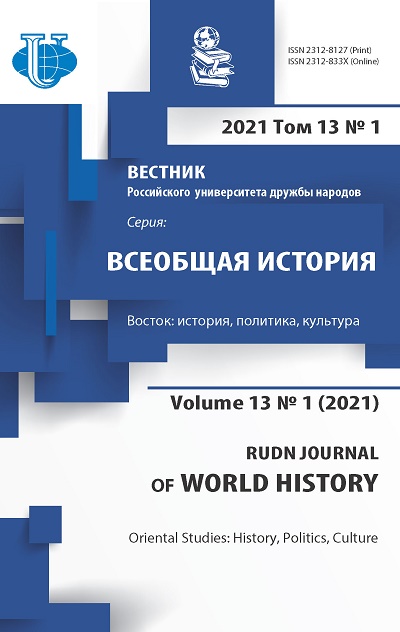Структурно-содержательный и археологический анализ эпитафии Чжао Жугуа (1170-1231 гг.)
- Авторы: Зайцев И.А.1, Колнин И.С.2
-
Учреждения:
- Институт Стран Азии и Африки МГУ им. М.В. Ломоносова
- Институт Востоковедения Российской Академии Наук
- Выпуск: Том 13, № 1 (2021): Восток: история, политика, культура
- Страницы: 77-95
- Раздел: Из истории Китая
- URL: https://journal-vniispk.ru/2312-8127/article/view/317231
- DOI: https://doi.org/10.22363/2312-8127-2021-13-1-77-95
- ID: 317231
Цитировать
Полный текст
Аннотация
Настоящая работа является продолжением двух опубликованных ранее работ, посвященных исследованию биографии Чжао Жугуа 趙汝适 (1170-1231 гг.), автора китайского историко-географического источника Чжу фань чжи 諸蕃志 («Описание всех иноземцев»; 1225 г.) [1; 2]. Цель статьи заключается в исследовании эпитафии Чжао Жугуа, что подразумевает разбор историко-археологических особенностей памятника (размер и материал), а также структурного анализа текста источника. В отличие от предыдущих работ надпись разбирается и как текстологический источник, и объект материальной культуры, что позволяет оценить контекст создания источника и степень детализации биографии усопшего.
Ключевые слова
Об авторах
Иван Алексеевич Зайцев
Институт Стран Азии и Африки МГУ им. М.В. Ломоносова
Автор, ответственный за переписку.
Email: gorniy_strannik@mail.ru
аспирант Института стран Азии и Африки
125009, Россия, г. Москва, ул. Моховая, 11Илья Сергеевич Колнин
Институт Востоковедения Российской Академии Наук
Email: minmi98@yandex.ru
лаборант-исследователь Отдела Китая ИВ РАН; магистрант Национального Исследовательского Университета «Высшая Школа Экономики»
107031, Россия, г. Москва, ул. Рождественка, 12Список литературы
- Kolnin IS. Biografija Chzhao Zhugua, avtora vazhnejshego opisanija inozemnyh stran XIII v. [Biography of Zhao Rugua, the Author of the Most Important Description of the Foreign Countries in the 13th Century]. Obshestvo i Gosudarstvo v Kitae. 2019; (49). (In Russ.).
- Kolnin IS. Some thoughts on Zhao Rugua’s biography and Zhufan zhi: translation and comparison of relevant fragments from various sources // Crossroads – Studies on the History of Exchange Relations in the East Asian World. 2019; (17).
- Ulyanov MYu. «Chzhu fan’ chzhi» («Opisanie inozemnyh stran») Chzhao Zhugua – vazhnejshij istoriko-geograficheskij istochnik kitajskogo srednevekov’ja. [«Zhu fan zhi» («The Description of Foreign Countries») by Zhao Rugua – the Most Important Historical Geographical Source of Medieval China]. Moscow: Vostochnaja literatura, 2019 (In Russ.).
- Ditter A. The Commerce of Commemoration: Commissioned Muzhiming in the Mid to Late Tang. Tang Studies. 2014; (34): 21–46. doi: 10.1179/0737503414z.00000000012.
- Rodin SA. Japonskie epitafii-bosi (VIII v.) [Japanese Epitaphs Boshi (8th c.)]. In: I.S. Smirnov, editor. History and Culture of Traditional Japan 2 (Works of Institute for Oriental and Classical Studies, Vol. XXIX). Moscow: RGGU; 2011. (In Russ.).
- De Groot JJM. The Religious System of China: Its Ancient Forms, Evolution, History and Present Aspect, Manners, Customs and Social Institutions Connected Therewith. Vol. 3. Leiden: Brill, 1897.
- Bossler B. Powerful Relations: Kinship, Status, and the State in Sung China (960–1279). Cambridge: Council on East Asian Studies, Harvard University, 1998. doi: 10.1163/9781684170234.
- Tackett N. The Destruction of the Medieval Chinese Aristocracy. Cambridge: Harvard University Press, 2014. doi: 10.1163/9781684170777.
- Schottenhammer A. Grabinschriften in der Song–Dynastie. Heidelberg: Edition Forum, 1995.
- Schottenhammer A. A Buried Past: The Tomb Inscription (Muzhiming) and Official Biographies of Wang Chuzhi (863–923). Journal of the Economic and Social History of the Orient. 2009; (52). doi: 10.1163/156852009x405339.
- Davies T. Entombed Epigraphy and Commemorative Culture in Early Medieval China: A History of Early Muzhiming. Leiden: Brill, 2015. doi: 10.1163/9789004306424.
- Fong M. Tang Line-Engraved Stone Reliefs from Shensi. Ars Orientalis. 1987; (17).
- Kryukov MV., Malyavin VV., Sofronov MV. Kitajskij etnos v srednie veka (VII–XIII vv.). [Chinese Ethnos in Medieval Times (VII–XIII cc.)]. Moscow: Nauka, 1984. 336 p. (In Russ.).
- Munkuyev NTs. Kitajskij istochnik o pervyh mongol’skih hanah. Nadgrobnaja nadpis’ na mogile Eljuj Chu-caja. [Chinese Source about the First Mongol Khans. Funerary Inscription on the Tomb of Yelü Chucai]. Moscow: Nauka, 1965. 224 p. (In Russ.).
- Dmitriev SV. Samyj vlijatel’nyj hristianin mongol’skoj imperii. Problemy rekonstrukcii biografii inozemca na mongol’skoj sluzhbe [The Most Influential Christian of the Mongol Empire. Problems of Reconstruction of a Biography of a Foreigner at the Mongol Service]. Obshestvo i Gosudarstvo v Kitae. 2005; (35). (In Russ.).
- Xu Sanjian 徐三见. Zhejiang Linhaishi faxian Songdai Zhao Rugua muzhi 浙江临海市发现宋代赵汝适墓志 [Discovery of an Entombed Epitaph of Zhao Rugua of the Song Dynasty in Zhejiang Province, Linhai City]. Kaogu 考古. 1987; (10). (In Chinese).
- Escher JB. New Information on the Degree of “Sinicization” of the Tuyuhun Clan during Tang Times through Their Marriage Alliances: A Case Study Based on the Epitaphs of Two Chinese Princesses. Journal of Asian History. 2019; (53). doi: 10.13173/jasiahist.53.1.0055.
- Mayers WF. The Chinese Government. A Manual of Chinese Titles, Categorically Arranged and Explained, with an Appendix. Shanghai: Kelly and Walsh, 1897.
- Papelitzky E. Historical Geographical Texts of the Late Ming (1368–1644) and China’s Maritime History [Dissertation]. Salzburg; 2017.
- Adamek P. Good Son is Sad If He Hears the Name of His Father: The Tabooing of Names in China as a Way of Implementing Social Values. Sankt-Augustin – Leeds: Routledge, 2015. doi: 10.4324/9781315093475.
- Chaffee J. Branches of Heaven: A History of the Imperial Clan of Sung China. Cambridge – Massachusetts – London: Harvard University Asia Center, 1999. doi: 10.2307/j.ctt1tg5hvk.
- Ouyang Xiu 歐陽修. Song shi. Di shisan ce 宋史. 第十三册 [History of the Song Dynasty. Vol. 13]. Shanghai: Hanyu dacidian chubanshe 漢語大詞典出版社, 2004. (In Chinese).
- Hucker CO. A Dictionary of Official Titles in Imperial China. Stanford: Stanford University, 1985.
Дополнительные файлы









